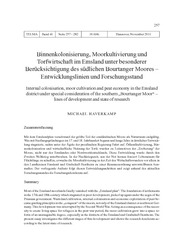Binnenkolonisierung, Moorkultivierung und Torfwirtschaft im Emsland unter besonderer Berücksichtigung des südlichen Bourtanger Moores – Entwicklungslinien und Forschungsstand
Haverkamp, Michael
41: 257 - 282
Haverkamp, Michael, 2011: Binnenkolonisierung, Moorkultivierung und Torfwirtschaft im Emsland unter besonderer Berücksichtigung des südlichen Bourtanger Moores – Entwicklungslinien und Forschungsstand. In: TELMA - Berichte der Deutschen Gesellschaft für Moor- und Torfkunde, Band 41: 257 - 282, DOI: 10.23689/fidgeo-2993.
 |
View/
|
Summary:
Most of the Emsland moorlands finally vanished with the „Emsland plan“. The foundation of settlements in the 17th and 18th century which stagnated in poor development, picked up again under the aegis of the Prussian government. Wasteland cultivation, internal colonisation and economic exploitation of peat became guiding principles in the „conquest“ of the moors, not only of the Emsland district or northwest Germany. This development was interrupted by the Second World War. Acting as a consequence of the necessity to create living space for refugees in the post-war period, the moor cultivation grew into a space reform of an unimaginable degree, especially in the districts of the Emsland and Grafschaft Bentheim. The present essay investigates the different stages of this development and shows the research desiderata according to the latest state of research. Zusammenfassung:
Mit dem Emslandplan verschwand der größte Teil der emsländischen Moore als Naturraum endgültig. Was mit Siedlungsgründungen im 17. und 18. Jahrhundert begann und lange Jahre in ärmlicher Entwicklung stagnierte, nahm unter der Ägide der preußischen Regierung Fahrt auf. Ödlandkultivierung, Binnenkolonisation und wirtschaftliche Nut zung der Torfe wurden zu Leitmotiven der „Eroberung“ der Moore, nicht nur des Emslandes oder Nordwestdeutschlands. Diese Entwicklung wurde durch den Zweiten Welt krieg unterbrochen. In der Nachkriegszeit, aus der Not heraus forciert Lebensraum für Flüchtlinge zu schaffen, erwuchs die Moorkultivierung in der Zeit des Wirtschaftswunders vor allem in den Landkreisen Emsland und Grafschaft Bentheim zu einer Raumneuordnung unvorstellbaren Ausmaßes. Der vorliegende Aufsatz folgt diesen Entwicklungsschritten und zeigt anhand des aktuellen Forschungsstandes die Forschungsdeside rata auf.

